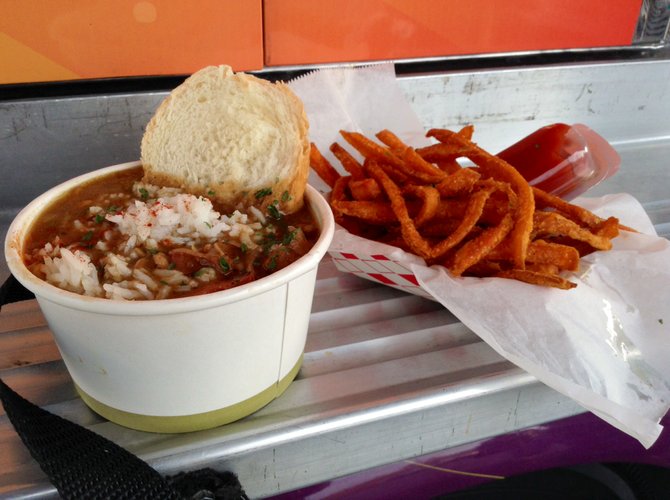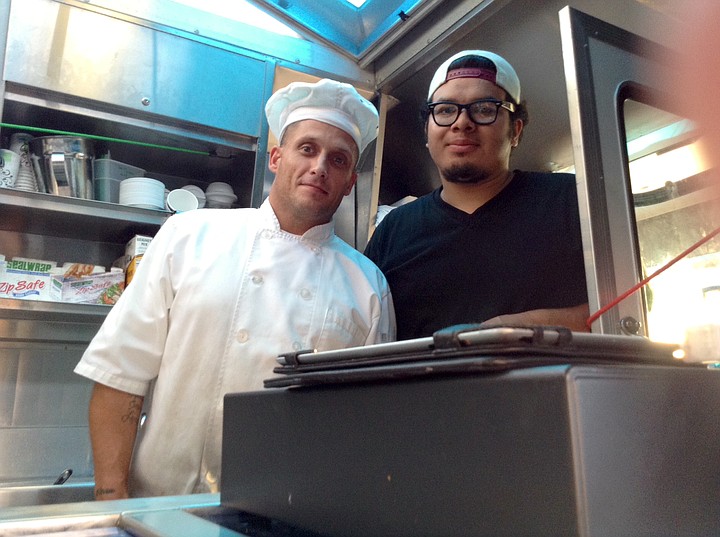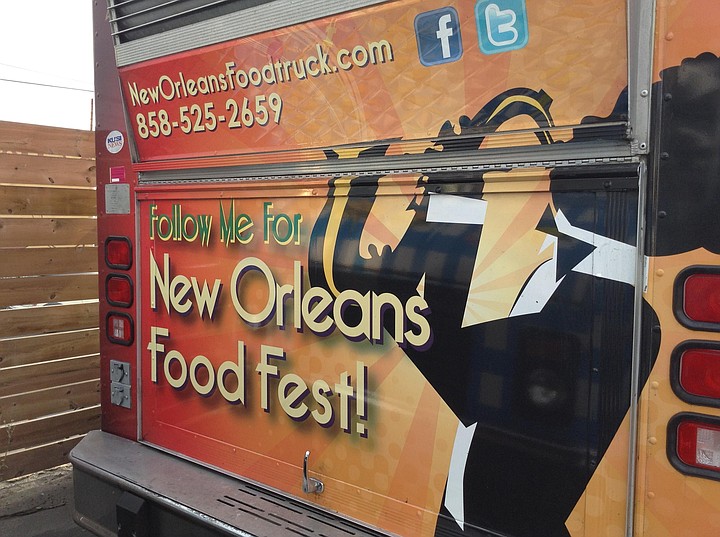 Facebook
Facebook
 X
X
 Instagram
Instagram
 TikTok
TikTok
 Youtube
Youtube

What's the difference between gumbo, jambalaya and étouffée? Tonight I've got a chance to find out. This is at 57 Degree's monthly food truck gathering (1735 Hancock Street, near Washington), and the last truck in the row in the parking lot turned out to be the New Orleans Food Truck.
Doing good business, too. I join the line as dusk gathers, and check out their menu. Ah, perfecto. They're doing all three, plus a shrimp and corn bisque ($5 small, $8 large), and an actual crab cake burger ($8), and sweet potato fries ($5). So when my turn comes, have to ask the Big Question. And wow. They have a proper chef aboard, with toque and white tunic, and a menu that checks all the right boxes when it comes to New Orleans chow.

Chef's name is Bobby Beigné and the guy taking the money is Jaime.
So, okay, what IS the difference between gumbo, jambalaya and étouffée?
"Talk to Bobby Beigné," says Jaime, at the order hatch. "He's the expert."
Bobby leans down so he can see through the serving hatch.
"Gumbo is the soup made with roux. Jambalaya is the spicy rice with sausage and chicken or beef. Étouffée is more like shrimp or crawfish with gravy."

I'm still trying to get this straight when the guy ahead of me in line recommends the gumbo. "It's a soup, but it's so thick you can just about eat it."
So I go ahead and order the $8 bowl (could have had the same size choices for jambalaya and étouffée), and add a basket of Cajun fries (sweet potato version). Two minutes later Bobby hands down this waxy paper pot brimming with the brown gloop, white rice sticking up, chunks of chicken, slices of sausage, and a slice of French bread to dip into it. Next to it, this paper plate of almost scarlet-red fries steams away.
The gumbo smells of...okra, I'm gonna guess, paprika, tomatoes, and the trinity of onions, bell peppers and, oh yeah, for sure: celery. The Cajuns call that trinity the "holy trinity" when they add garlic. For sure it's the full holy trinity in this mix. In texture it kinda reminds you of the muddy banks of the mighty Mississippi. Whereas jambalaya is a kind of paella.
Turns out the name "gumbo" probably comes from Africa, from "ki ngombo," the Bantu word for okra. But it just might have come from "kombo," the American Indian word for the Choctaw spice, filé, ground from dried sassafras leaves.
So a heckuva lot of history to each bite here. My favorite part is dipping the bread into it. Something about the bread and soup taste combo is magic.
But bottom line: this gumbo from the land of the mighty Mississippi is mighty mighty filling. Guess I'll have to come back for the jambalaya and étouffée some other time.


What's the difference between gumbo, jambalaya and étouffée? Tonight I've got a chance to find out. This is at 57 Degree's monthly food truck gathering (1735 Hancock Street, near Washington), and the last truck in the row in the parking lot turned out to be the New Orleans Food Truck.
Doing good business, too. I join the line as dusk gathers, and check out their menu. Ah, perfecto. They're doing all three, plus a shrimp and corn bisque ($5 small, $8 large), and an actual crab cake burger ($8), and sweet potato fries ($5). So when my turn comes, have to ask the Big Question. And wow. They have a proper chef aboard, with toque and white tunic, and a menu that checks all the right boxes when it comes to New Orleans chow.

Chef's name is Bobby Beigné and the guy taking the money is Jaime.
So, okay, what IS the difference between gumbo, jambalaya and étouffée?
"Talk to Bobby Beigné," says Jaime, at the order hatch. "He's the expert."
Bobby leans down so he can see through the serving hatch.
"Gumbo is the soup made with roux. Jambalaya is the spicy rice with sausage and chicken or beef. Étouffée is more like shrimp or crawfish with gravy."

I'm still trying to get this straight when the guy ahead of me in line recommends the gumbo. "It's a soup, but it's so thick you can just about eat it."
So I go ahead and order the $8 bowl (could have had the same size choices for jambalaya and étouffée), and add a basket of Cajun fries (sweet potato version). Two minutes later Bobby hands down this waxy paper pot brimming with the brown gloop, white rice sticking up, chunks of chicken, slices of sausage, and a slice of French bread to dip into it. Next to it, this paper plate of almost scarlet-red fries steams away.
The gumbo smells of...okra, I'm gonna guess, paprika, tomatoes, and the trinity of onions, bell peppers and, oh yeah, for sure: celery. The Cajuns call that trinity the "holy trinity" when they add garlic. For sure it's the full holy trinity in this mix. In texture it kinda reminds you of the muddy banks of the mighty Mississippi. Whereas jambalaya is a kind of paella.
Turns out the name "gumbo" probably comes from Africa, from "ki ngombo," the Bantu word for okra. But it just might have come from "kombo," the American Indian word for the Choctaw spice, filé, ground from dried sassafras leaves.
So a heckuva lot of history to each bite here. My favorite part is dipping the bread into it. Something about the bread and soup taste combo is magic.
But bottom line: this gumbo from the land of the mighty Mississippi is mighty mighty filling. Guess I'll have to come back for the jambalaya and étouffée some other time.
Comments